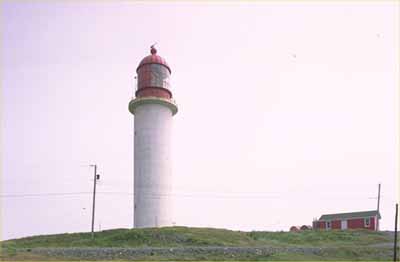Cape Race Lighthouse National Historic Site of Canada
Cape Race, Newfoundland and Labrador

General view
(© Parks Canada Agency / Agence Parcs Canada, 1990.)
Address :
off Route 10, Cape Race, Newfoundland and Labrador
Recognition Statute:
Historic Sites and Monuments Act (R.S.C., 1985, c. H-4)
Designation Date:
1975-05-18
Dates:
-
1907 to 1907
(Construction)
Event, Person, Organization:
-
Steel Concrete and Co.
(Architect)
Other Name(s):
-
Cape Race Lighthouse
(Designation Name)
Research Report Number:
1974-L, 2005-SDC/CED-040
DFRP Number:
00004 00
Plaque(s)
Existing plaque: Cape Race, Newfoundland and Labrador
Built in 1907 by the Canadian government, this lighthouse, on the approaches to the nation's busiest shipping lane, replaced an earlier one erected by the imperial government in 1856 on the same site. Its overall height of 96 feet comprises a circular stone and concrete tower 68 feet high surmounted by a lantern over 17 feet in diameter. The lantern originally housed a petroleum vapour light rotated by a clockwork mechanism on a mercury float. The massive optic, made by Chance Brothers of Birmingham, emitted a flash of over 1,000,000 candle power. The light was electrified in 1926.
Description of Historic Place
The Cape Race Lighthouse National Historic Site of Canada is situated on a remote headland on the Avalon Peninsula in Newfoundland. The stone and reinforced concrete tower consists of a smooth, plain cylinder crowned by a circular metal lantern surrounded by a concrete walkway and railing. The lighthouse stands amongst smaller support buildings. Its strategic location makes it highly visible to maritime traffic. The official recognition refers to the lighthouse on its legal property.
Heritage Value
Cape Race Lighthouse was designated a national historic site of Canada in 1974 because: it was the most important landfall light built on the dangerous and fog-bound southern shore of Newfoundland's Avalon peninsula to guide ships heading through the Cabot Strait for Canada; and,
- installation of a new lighting apparatus in 1907 meant it housed one of the most powerful lights in the world.
The heritage value of this site resides in the physical presence of the lighthouse, witness to the importance of the Cabot Strait shipping lane. It also resides in the design and stout construction of this tower, which housed a powerful light. The Cape Race Lighthouse also illustrates the improvement of aids to navigation on the east coast of Canada. Designed by Steel Concrete Co. it represents a pioneering example of maritime design and engineering in Canada. Built in 1907 by the Canadian government, this lighthouse, which marks the entrance to the nation’s busiest shipping lane, replaced an earlier light tower erected by the imperial government in 1856 on the same site.
Source: Historic Sites and Monuments Board of Canada, Minutes, June 1974.
Character-Defining Elements
The key elements that contribute to the heritage character of this site include: the highly visible location on a rugged headland; the unimpeded, open viewscapes; the maritime coastal setting at the edge of the Cabot Strait; the stone and reinforced concrete construction; the form and massing of the 20.72 metres high structure which consists of a tall, cylindrical tower and a lantern; the metal lantern; the exterior concrete gallery with railing; the small square windows and door; the smooth, cement washed finish of the unadorned exterior walls with its distinguishing colour scheme of white and red.